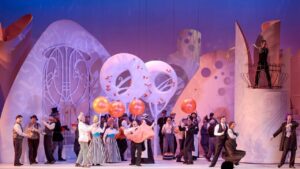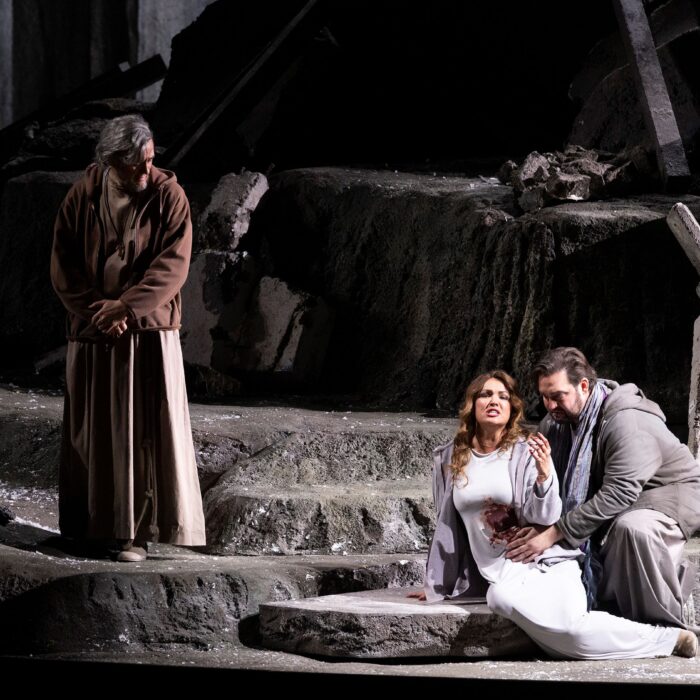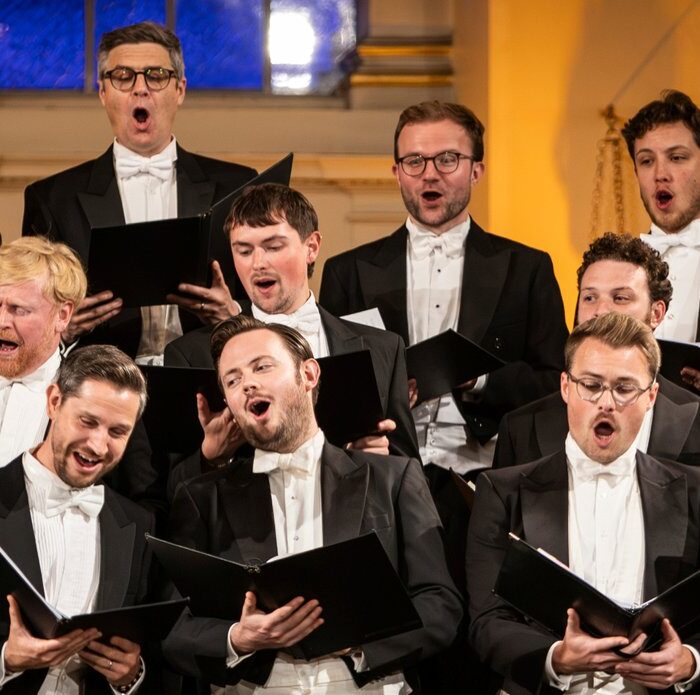
Lyric Opera of Kansas City 2024-25 Review: The Barber of Seville
Vibrant Set Design by Ken MacDonald & Illuminating Cast Bring Rossini’s Masterpiece Full Circle
By Stan Fairbank(Photo:
“The Barber of Seville” debuted just over 200 years ago in Rome. The opera played to a jeering audience, a staged event where adherents of the composer Giovanni Paisiello – whose own version of the opera, “Il barbiere di Siviglia, ovvero La precauzione inutile” had pleased operagoers 20 years earlier – packed the house and catcalled throughout the premiere performance. Their objective was to defend the memory of their maestro’s earlier work that they felt was the definitive version. But the Paisiello mob couldn’t show up every night, and upon the conclusion of the second evening’s undisturbed performance the response from the audience was ecstatic – they adored it so much that a large group of the crowd took to the streets with torches and made their way to Rossini’s home to cheer him in person. And a hit was born.
Incredibly, for someone who writes about opera, I didn’t know the entire story of “Barber” until the final curtain of this performance. But I like the fact that I am sometimes ignorant of operatic plots because seeing and hearing a classic work of music for the first time is like breaking the shrink wrap on an LP you’ve never heard, putting the disk on the turntable, and experiencing it as if you were living in the time it was created. It’s a special thing. Even more special when you can take yourself not just back to 1988 with an unopened virgin vinyl of Lovesexy, but back 200 years ago into post-Napoleonic Europe for an essential comic romp that would never be out of repertory or out of fashion.
The absurdist tale of “Barber” concerns a distinguished nobleman, Count Almaviva, who is intent on wooing Rosina, a beautiful young woman of the town. He wants to know Rosina might love him for himself and not for his money and position. Rosina is being kept as a ward of Doctor Bartolo, one of the local bourgeoise. Bartolo intends on marrying Rosina himself when she comes of age, so he keeps a close watch on her as well as other potential suitors which complicates Almaviva’s creative courtship plans. With the help of his friend Figaro, Almaviva goes incognito to advance his agenda with Rosina under the nose of Bartolo which results in much hilarity over the opera’s two and a half hour runtime.
It is fascinating that this opera’s broad humor has stood the test of time so well. As presented by the Lyric it got robust laughter out of all in attendance, a portion of whom had surely seen it before. It seems improbable that the humor of Cesare Sterbini’s featherlight crowd-pleaser has endured as well as works from Fielding, Sterne, Twain, and Voltaire – but one can’t argue with results.
Illuminating Production & Cast
The seats at the Kauffman were filled for this opening night performance, thanks to an abundance of late summer advance press, and the local gentry showing up in force for the farce. Our philanthropists, local musician wunderkinder, and hoi polloi like me all crowded into the Founder’s Lounge for a pre-show nosh so delightful that we barely made it into our seats for first curtain.
As the curtain parted after the overture, I was entranced by the set design. The KC Lyric doesn’t have the large budgets that America’s larger opera companies have at their disposal, so they have to make do with less. And, true to form, they excelled in that department with “Barber.” The set and props from Ken MacDonald were a true delight. I could tell from the jump that the set would remain pretty much intact for both acts, but the continuity worked just fine and once again less was more on the Kaufmann stage.
Aside from familiar face Riley Findley, who played one of the military officers, the cast was assembled from out-of-towners. Matthew Swensen was an expansive Count Almaviva, carrying the action with fantastic energy and verve. Kristinn Sigmundsson as Don Basilio was a standout for spot-on casting. His befuddlement during the music lesson “mixup” was well-played.
Highly-respected globetrotting mezzo-soprano Chrystal E. Williams sparkled as Rosina. Handled the butterfly melodies of “Contro Un Cor Che Accende Amore” beautifully and her turn in the scene’s comic ensemble had us all smiling.
My personal favorite among the cast was Ashraf Sewailam as the Doctor. He projected a thick-headed pomposity of Yul Brynner proportions, stealing scene after scene whirling around the stage in that smoking robe whose design looked like it was inspired by an article on interior trends in Dwell (“Wallpaper… It’s Baaaack!”).
The orchestra was handled ably by James Lowe, a musician/conductor/arranger whose career has steered a steady course fixed to the white line in the road separating Broadway and classical opera. He’ll never be in the running for conducting “Aida,” but “Bye Bye Birdie” revivals probably aren’t in his future either. All in all, a good mainstream choice to helm the KC crew for this enjoyable affair.
More Production Highlights
When I left the Kaufmann Center, after the performance, I had a vague feeling of timeliness about the production. With all due respect to the singing and acting talent in this production, for me the real star was Ken MacDonald for creating that wild set. With their faux-Moorish look it wasn’t hard to imagine them to be found not only in the homes of the nobles of early 19th century Spain, but other eras as well: The Belle Époque of King Umberto I. The Euro deco of early Fascist Italy. That sculpted window and pianoforte bianco he worked out for the singing lesson scene would not have looked out of place in any escapist “white telephone” film of 1930’s Italy. Or in later Cinecitta films from Fellini, particularly in later films like “And The Ship Sails On,” which play on memories of a decaying continental aristocracy. And yes, one might even see something like them today in the homes of European football superstars, Russian oil barons, or tech oligarchs – villas equipped with interiors that make pretentious reference to earlier times when aristocratic power went unchallenged and the term “working class” referred to domestic servants and itinerant laborers forced to exist in squalor and despair.
Rossini and Sterbini created Barber amid a social environment of upheaval and uncertainty. The Italy (or more accurately the Italian Papal States) of 1816 was in political disarray following the Congress of Vienna, which reconstructed Europe more or less by the whim of the largest nations who were victorious over Napoleon. The Napoleonic reforms that had introduced new freedoms to the middle and working classes were rolled back, and patriots found that their country had been sold out to the Central Powers. Italian nationalists, particularly the revolutionary Carbonari, reflected a bitterly divided nation.
For many artists of the day, it was a time to take risks and express solidarity with the resistance. But Rossini’s political overtones were always subtle, and the way he weaves the silken threads of his social comment into the tapestries of his operas is the main part of his genius. If he had delivered his social critiques with a heavier hand, his works may not have survived the era of Garibaldi. In “The Barber of Seville,” Rossini and Sterbini realized that the one constant in the world is that things will always be batshit crazy. And while the public may at times crave outrage in their art, and at other times seek messages of hope and salvation – it’s certain that they will always need a laugh.
Categories
Reviews


